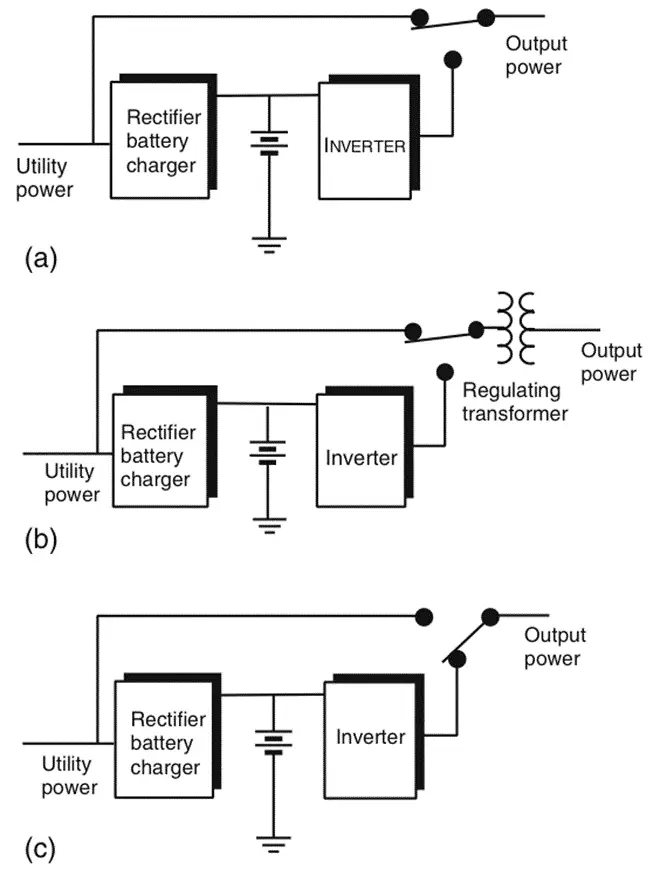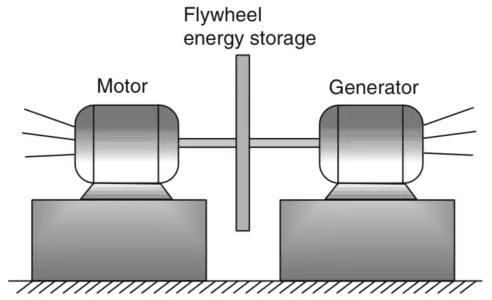One method of protecting sensitive equipment against power interruptions is the uninterruptible power supply (UPS). The UPS has become very popular as the cost of power electronics has decreased.
Uninterruptible Power Supply Working
Figure 1 shows the principles of operation of an electronic UPS. Single- or three-phase power is obtained from the power system and is rectified to DC. Floating on the DC bus is a battery bank that provides energy storage to keep the system operating during an interruption. Clearly, the larger the battery bank, the longer the system can operate. The DC voltage is then inverted back to single- or three-phase 60 Hz AC to operate the load. This is the normal mode of operation.
Emergency Mode
Note that the input and output do not have to have the same number of phases; i.e., single- to three-phase conversion is possible. In the event the AC source experiences an interruption, the battery bank continues to supply energy to the inverter, which in turn supplies AC power to the load. This is called the emergency mode of operation.
Recovery Mode
When power is restored, the batteries must be recharged, which is called the recovery mode. Typically, large UPS systems are sized to provide power until a backup generator can be started or to allow an orderly shutdown of the load equipment.
Bypass Circuits
Since no system can run 100% of the time forever, there are bypass circuits as well. The first is a so-called static switch that can reconnect the load to the input power (assuming they are the same number of phases, of course) within a quarter cycle to keep the load running in the event of a problem in the UPS. The second bypass is a set of manually operated switches that allow the UPS to be disconnected from the circuit for maintenance, which is the bypass mode of operation.
UPS systems now are available in sizes ranging from 200 watts or so to operate a single personal computer, to hundreds of kilowatts to operate mainframe systems or essential systems in a plant. Because the source voltage does not reach the load, a UPS provides excellent protection against transients and EMPRFI. It is important to note that UPS systems for personal computers are not designed to handle the large currents drawn by a laser printer when its fuser element heats up. Thus, a laser printer should never be connected to a UPS.
FIGURE 1 UPS block diagram.
UPS Systems for Personal Computers
UPS systems for personal computers come in a wide range of prices, even for similar power ratings. As with many things, the old adage is true—“You get what you pay for.” Figure 2 shows three different types of UPS systems.
Uninterruptible Power Supply Types
Standby UPS
Figure 2(a) shows a so-called standby UPS. In this scheme, the computer actually receives utility power during normal operation. The reason for this is that to cut cost, the inverter is not rated for continuous operation. In addition, the inverter may only provide a square-wave voltage at the output. Typically, this type of UPS includes a TVSS to protect the computer against surges. However, if the voltage varies in magnitude or frequency, the computer sees the variation.
When the voltage falls below some predetermined limit, such as —10%, a switch moves the load to the output of the inverter. The switch is usually rated to operate at 4 ms; however, it does not start delivering voltage until the next voltage zero, which could be a half-cycle or 8 ms. Standby UPS systems with a 200-watt rating are available for as little as $80. The low cost is the advantage of the standby UPS.
FIGURE 2 UPS types (a) standby, (b) line-interactive, and (c) continuous.
Line-Interactive UPS
Figure 2(b) shows another type of UPS, called the line-interactive UPS. The operation is similar to the standby UPS in that utility power is delivered during normal operation. The reader should be aware when reading advertisements for this type of UPS that this fact is often completely glossed over.
The line-interactive UPS has a better inverter than the standby UPS and provides a better approximation to a sine wave at its output. It also has a buck-boost regulating transformer to change the voltage level during moderate under- and overvoltages. Line-interactive UPS systems cost $200 and up, depending on the size.
The third type of UPS is shown in Figure 2(c) and is what is usually thought of when the term UPS is used. In this case, the inverter is rated for continuous output and provides a true sinusoidal voltage waveform. Power to the load always comes from the inverter, unless there is a failure in the UPS, in which case power reverts back to the utility. The rectifier-inverter UPS is the most expensive of the three types, costing $600 and up for a single personal computer.
All three types of UPS systems are available with software that communicates to the computer. In the event of an extended power failure, the software can ensure a graceful shutdown of any applications that are open as well as the operating system. The software also allows data logging of power discrepancies, such as low voltage. Users should beware, however, that the files created by the data logging can become quite large over time if they are not periodically purged.
Motor-Generator Set
Another alternative for uninterruptible power is a motor-generator set, as shown in Figure 3. In this case, the utility power runs the motor, which turns the generator to supply power to the load. Usually, a flywheel is added to provide enough energy storage to continue running the generator through brief interruptions.
Another alternative is to have connected to the set an engine that starts up before the flywheel energy is depleted, providing power for longer interruptions. Motor-generator sets were more popular before the electronic UPS became cost-effective and were also used for frequency changing—to provide 400 Hz power to mainframe computers, for example. Of course, an electronic UPS can also do frequency conversion.
One machine plant in Florida found that short interruptions were causing severe problems. They installed the electronic rectifier and inverter as shown in Figure 1, but instead of a battery bank, they used a state-of-the-art flywheel with a DC generator. The flywheel is contained in a vacuum with magnetic bearings to minimize losses and can provide up to 800 kW for several minutes. That particular plant found that they average 200 sags or surges per day and 90% of them last less than two seconds.
There are other devices available to improve power quality. Where sags or swells are a problem, voltage regulators can be used to maintain the desired voltage.
There are several types of voltage regulators on the market. EMI/RFI noise can be dealt with using an isolation transformer, which uses a grounded shield between the primary and secondary windings to prevent capacitive coupling of the noise.
FIGURE 3 Motor-generator UPS with flywheel energy storage.


